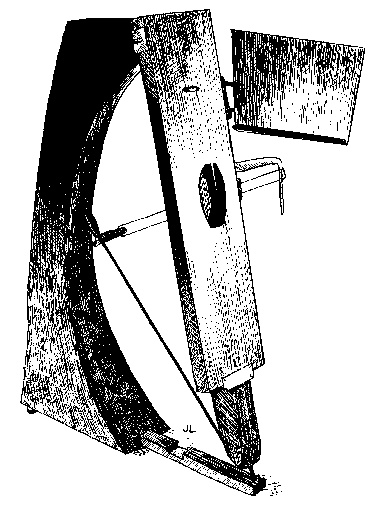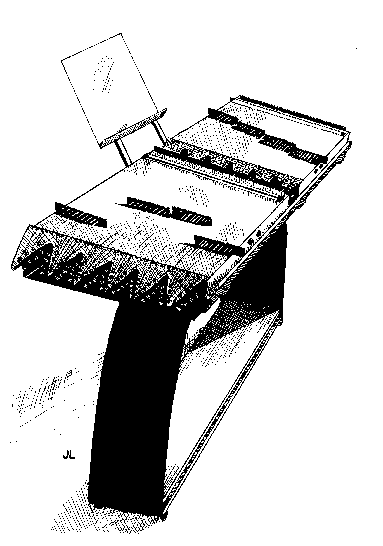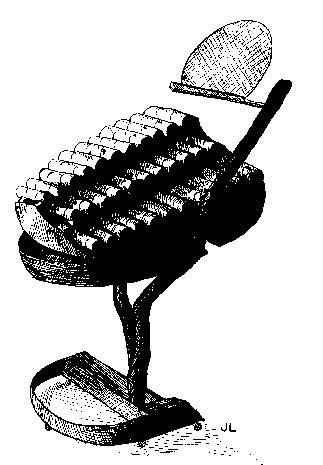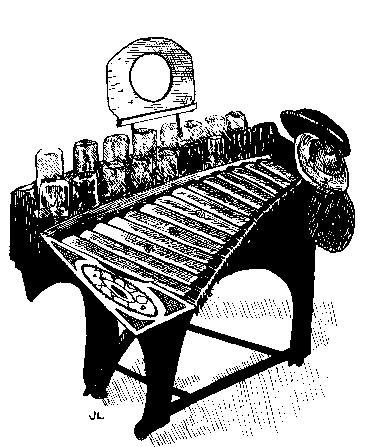The Instruments of Harry
Partch
I could easily write an article on Harry Partch's instruments
alone. However, as Partch devoted 125 pages (Chapters 12 &
13) to them in Genesis of a Music, I will present here
only enough to provoke the curious to seek out his book.
String, Reed and Voice Instruments
Adapted Viola -- The fingerboard
of a standard viola was lengthened to extend the range partially
into cello territory, and small colored dots were added to make
possible the performance of the exact tones of Partch's scale.
Adapted Guitars -- The
fingerboards of these were also modified, and the second of three
versions was a Hawiian-type guitar where a lead-weighted plastic
rod was moved along the fingerboard to give sliding tones.
Chromelodeon I -- A harmonium
(reed organ) adapted to Partch's scale.
New Chromelodeon II --
Similar to above, though with a longer keyboard.
 Crychord
-- This was built by a student in the Industrial Design Department
of the University of Illinois, with additional suggestions by
Partch. The instrument has a single string (usually struck or
plucked by a stick), the tension of which is adjusted by the long
lever. Exact intonation is difficult; the tones slide into one
another. Partch used the Crychord primarily to improvise with
a known, precomposed part.
Crychord
-- This was built by a student in the Industrial Design Department
of the University of Illinois, with additional suggestions by
Partch. The instrument has a single string (usually struck or
plucked by a stick), the tension of which is adjusted by the long
lever. Exact intonation is difficult; the tones slide into one
another. Partch used the Crychord primarily to improvise with
a known, precomposed part.
Kithara I & New Kithara I
-- Seventy-two vertical strings (twelve groups of sixes) provide
a wide range of performance techniques in an alto register on
these two different versions.
Kithara II -- Similar to
the above in a bass register.
Surrogate Kithara -- Built
to ease the playing of certain difficult musical parts for the
above, this version consists of two horizontal resonators (canons)
of eight strings each.
Harmonic Canon I & New Harmonic
Canon I -- Two sets of fourty-four strings are set
on two different intersecting planes so that one set is played
on one end, the other set on the other side, and in the middle
both sets of strings are played.
Harmonic Canon II -- Simlar
to version III described below, but with only two canons (Castor
& Pollux).
Harmonic Canon III (Blue Rainbow)
-- With three separate sets (or canons) of fourty-four strings
(only two canons pictured) this is an example of one of Partch's
more versatile instruments. Each canon is divided into four sections
of eleven strings. All eleven strings of a series are tuned to
the same tone; hence, notes played exhibit a dynamic, rapid staccato
nature as several equal strings are struck for a single tone.
The supporting arch acts as a fulcrum so that in vigorous playing
the canons sway lightly up and down to the rhythm.
Bloboy -- This is a bellows
controlled by the foot with three organ pipes and an ancient auto
exhaust horn of four tones attached.
Koto -- Not a traditional
Japanese koto, but rather a Psaltery with thirteen strings.
Vocals -- These are usually
supported by unisons or other simple ratios by the instruments.
With this method Partch found it was fairly simple for singers
to cope with the new scale.
Percussion Instruments
Diamond Marimba -- Thirty-six
wood blocks with bamboo resonators were arranged in the shape
of a diamond, so that the blocks could be swept in two different
(criss-crossing) directions for arpeggioed chords.
Quadrangularis/Reversum
-- This is actually a Diamond Marimba with the tones reversed
from top to bottom, and with the addition of two larger, separate
rows of blocks on each side.
Bass Marimba -- Eleven
Sitka-spruce blocks from 27 to 53 inches long provide the playing
surface, with organ pipes serving as resonators.
Marimba Eroica -- Built
in four separate pieces, this large instrument gives four tones
lower than the Bass Marimba and is designed to be felt more than
heard. The lowest tone is struck by a four pound mallet.
Boos (Bamboo Marimbas) I & II
-- These consist of sixty-four pieces of bamboo tuned by cutting
a tongue of the necessary ratio into the wood.
Mbira Bass Dyad -- An instrument
which duplicates the tongue-with-resonator idea of the Boos, but
with two (adjustable) low tones.
 Eucal Blossom
-- Made from bamboo and mounted on eucalyptus boughs, this instrument
gives sharp, dry sounds. It is played by mallets with large oak
heads, and occasionally lighter wood-head mallets, with glissandi
being a useful technique.
Eucal Blossom
-- Made from bamboo and mounted on eucalyptus boughs, this instrument
gives sharp, dry sounds. It is played by mallets with large oak
heads, and occasionally lighter wood-head mallets, with glissandi
being a useful technique.
Gourd Tree and Cone Gongs
-- A dozen Chinese temple bells were bolted to gourds of equal
pitches and affixed to a large eucalyptus bough. The two large
cone gongs (nose cones from airplane gas tanks) are supported
from the floor by a different base.
Cloud-Chamber Bowls --
Suspended by 1/4-inch manila rope are fourteen sections of twelve
gallon Pyrex carboys which give long, delicate tones.
Spoils of War -- As hinted
by its title, this instrument consists of a variety of items:
one Pernambuco (bass wood) block, seven brass shell casings, four
Cloud-Chamber Bowls, two tongued pieces of bamboo with both ends
open, three Whang Guns (strips of spring steel controlled by pedals),
and one gourd guiro (scraped to give a rasping noise).
 Zymo-Xyl (zi'-mock-sil)
-- This instrument consists of one row of wood blocks, two rows
of empty liquor and wine bottles, two hubcaps, and an aluminum
kettle top. Partch tested a number of bottles to find the ones
with the exact pitches of his scale. The frequency range of the
Zymo-Xyl emphasizes the higher registers.
Zymo-Xyl (zi'-mock-sil)
-- This instrument consists of one row of wood blocks, two rows
of empty liquor and wine bottles, two hubcaps, and an aluminum
kettle top. Partch tested a number of bottles to find the ones
with the exact pitches of his scale. The frequency range of the
Zymo-Xyl emphasizes the higher registers.
Mazda Marimba --
Light bulbs and globes up to six inches in diameter had their
insides removed and were inverted on four parallel racks for playing.
The sounds, which Partch likened to "the bubbling of a coffee
percolator," must be miked and amplified.
Small Hand Instruments
-- Twenty-one different items, mostly unusual
varieties of drums, and claves (pairs of bamboo or eucalyptus
boughs struck together), were included in this category.
Go to The
Quality of Vitality: Music by Harry Partch
back to the Harry Partch page

 Crychord
-- This was built by a student in the Industrial Design Department
of the University of Illinois, with additional suggestions by
Partch. The instrument has a single string (usually struck or
plucked by a stick), the tension of which is adjusted by the long
lever. Exact intonation is difficult; the tones slide into one
another. Partch used the Crychord primarily to improvise with
a known, precomposed part.
Crychord
-- This was built by a student in the Industrial Design Department
of the University of Illinois, with additional suggestions by
Partch. The instrument has a single string (usually struck or
plucked by a stick), the tension of which is adjusted by the long
lever. Exact intonation is difficult; the tones slide into one
another. Partch used the Crychord primarily to improvise with
a known, precomposed part.
 Eucal Blossom
-- Made from bamboo and mounted on eucalyptus boughs, this instrument
gives sharp, dry sounds. It is played by mallets with large oak
heads, and occasionally lighter wood-head mallets, with glissandi
being a useful technique.
Eucal Blossom
-- Made from bamboo and mounted on eucalyptus boughs, this instrument
gives sharp, dry sounds. It is played by mallets with large oak
heads, and occasionally lighter wood-head mallets, with glissandi
being a useful technique. Zymo-Xyl (zi'-mock-sil)
-- This instrument consists of one row of wood blocks, two rows
of empty liquor and wine bottles, two hubcaps, and an aluminum
kettle top. Partch tested a number of bottles to find the ones
with the exact pitches of his scale. The frequency range of the
Zymo-Xyl emphasizes the higher registers.
Zymo-Xyl (zi'-mock-sil)
-- This instrument consists of one row of wood blocks, two rows
of empty liquor and wine bottles, two hubcaps, and an aluminum
kettle top. Partch tested a number of bottles to find the ones
with the exact pitches of his scale. The frequency range of the
Zymo-Xyl emphasizes the higher registers.